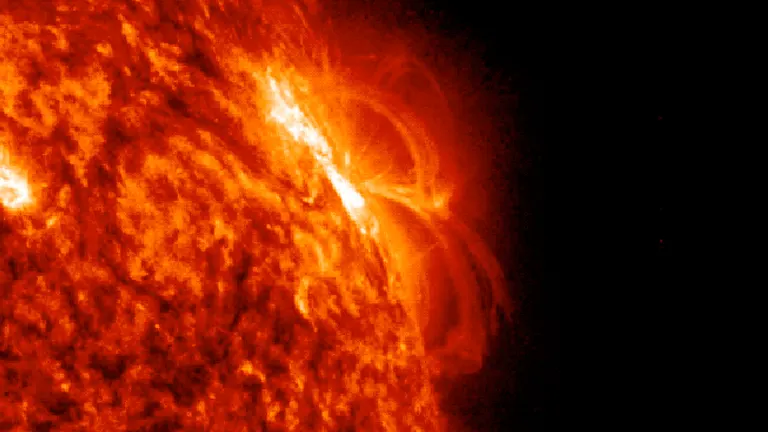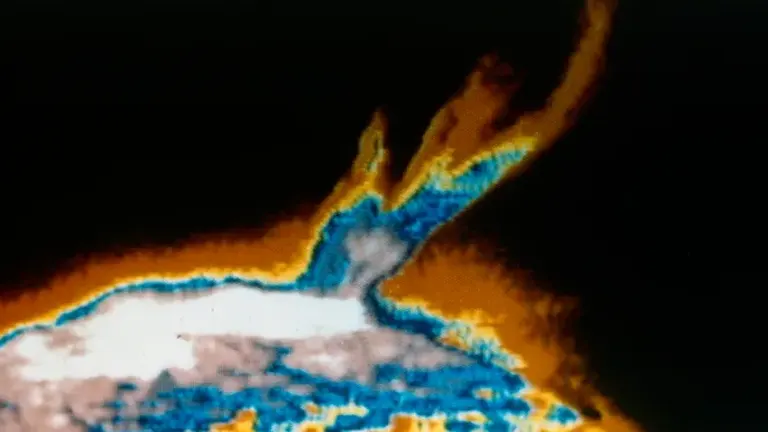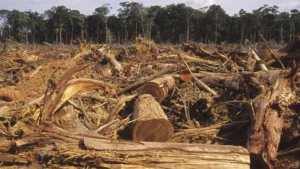The Hidden Threat of Solar Superstorm: A Forestry Perspective
- November 21, 2023
- 2 comment
While the mesmerizing auroras paint the night sky, signaling the presence of solar storms, few realize the lurking danger of an “internet apocalypse” as described by Professor Peter Becker of George Mason University. As we enter an era of heightened solar activity, the intersection of our reliance on the internet and this increased solar activity poses unprecedented risks, not just to technology, but also to the less-discussed realm of forestry.

(Solar Dynamics Observatory / NASA)
Is The Solar Superstorm Real?
Yes, solar superstorms are real and are a natural part of the sun’s activity cycle. These events involve massive eruptions on the sun’s surface, including solar flares and coronal mass ejections (CMEs). Solar flares are intense bursts of radiation, and CMEs involve huge bubbles of gas and magnetic fields being ejected from the sun. When these reach Earth, they interact with the Earth’s magnetic field, potentially causing geomagnetic storms.
Understanding Solar Superstorm
Solar superstorms, a formidable display of our sun’s power, involve two primary phenomena: solar flares and coronal mass ejections (CMEs). These events represent more than just spectacular space weather; they are powerful forces capable of affecting our planet in profound ways.
1. The Nature of Solar Superstorms: At their core, solar superstorms consist of immense bursts of energy and superheated plasma that the sun ejects into space. Solar flares, intense bursts of radiation, can happen suddenly and are often associated with sunspots. Coronal mass ejections, on the other hand, involve a significant release of plasma and magnetic field from the solar corona, the sun’s outer atmosphere. These CMEs can send billions of tons of solar material hurtling through space at incredible speeds.
2. Earthly Impacts: When these solar emissions, particularly CMEs, collide with Earth’s magnetic field, they can create geomagnetic storms. These storms are responsible for the beautiful auroras, but their impact goes far beyond these light displays. They can disrupt satellite operations, affect power grids, and interfere with communication systems. The work of Professor Becker, in collaboration with the Naval Research Laboratory, focuses on developing an early warning system to provide a crucial 18 to 24 hours notice before a solar superstorm hits. This advance warning is vital for preparing and mitigating the potential technological disruptions.
3. Beyond Technology: While much of the focus on solar superstorms centers on their technological impacts, their influence extends further. The interaction of these storms with Earth’s magnetic field can have broader implications, potentially affecting various aspects of our environment and even our climate systems. Understanding these impacts is crucial for preparing for and adapting to these extraordinary space weather events.
Historical Context: The Carrington Event
“The Carrington Event of 1859, named after the British astronomer Richard Carrington who first observed the associated solar flare, stands as a historical benchmark in our understanding of solar superstorms. This event, the most significant coronal mass ejection (CME) known to have directly impacted Earth, resulted in a massive geomagnetic storm. Its effects were most notably observed in the telegraph systems of the time, the then-epitome of communication technology. Telegraph operators reported electric shocks, papers caught fire, and systems operated even when disconnected from power, all due to the electromagnetic disturbances caused by the solar storm.

(Heritage Space/Heritage Images)
This historical precedent serves as a stark reminder of the vulnerability of our modern, technologically advanced society. Today’s intricate and sensitive systems, from internet infrastructure to satellite communications and power grids, could face catastrophic disruptions if a similar event were to occur. The Carrington Event underscores the importance of understanding solar superstorms and preparing for future occurrences. It highlights the need for resilient infrastructure and effective early warning systems, like those being developed by Professor Becker and the Naval Research Laboratory, to mitigate potential consequences in our increasingly technology-dependent world.
How Solar Superstorms Affect Our Forests
- Technology in Forestry at Risk: In the modern era, the forestry sector has become increasingly reliant on advanced technology. From satellite imagery for monitoring vast forest areas to GPS systems essential for precise data collection and effective communication, technology is at the heart of contemporary forest management. However, the intense electromagnetic disturbances caused by solar superstorms pose a significant threat to these critical tools. The potential damage to satellites and communication networks could severely impair our ability to manage forests, particularly in critical situations like combating wildfires or curbing illegal logging activities.
- Ecological Changes: Beyond technological disruptions, solar superstorms could also have a profound impact on the ecological balance within forest ecosystems. Fluctuations in the Earth’s magnetic field and variations in radiation levels, a byproduct of these cosmic events, might subtly yet significantly alter the natural processes. This could manifest in changes to plant growth patterns, animal behaviors, and potentially even lead to shifts in species distributions. Such changes are not just a concern for the health of the forests but could also have far-reaching implications for global biodiversity.
- Economic Impact: Forests are not just ecological powerhouses but also vital economic engines. Their contributions extend beyond the timber industry, encompassing ecotourism and the provision of crucial ecosystem services. A solar superstorm, with its capacity to cause prolonged technological disruptions, could have a ripple effect, leading to substantial economic losses in these sectors. The downtime in forest management and conservation efforts, coupled with the potential ecological impacts, could have far-reaching consequences for the global economy, particularly in regions heavily reliant on forestry-related industries.
Solar Superstorm Prediction Date
Predicting the exact timing of the next super solar storm is a challenge that continues to elude scientists. However, based on solar activity patterns, experts suggest that such an event could occur within the next few decades. The sun operates on an 11-year cycle of solar activity, with the current cycle anticipated to reach its peak around 2024. During these peak periods, the likelihood of the sun producing intense solar flares and coronal mass ejections (CMEs) increases significantly. It’s these solar phenomena that have the potential to unleash super solar storms upon colliding with Earth.
The historical Carrington Event of 1859, the most powerful solar storm recorded, serves as a sobering example of the potential impact. This event wreaked havoc on the telegraph systems of the time and generated auroras visible as far south as Cuba. In today’s world, where society is deeply intertwined with technology, a super solar storm of similar magnitude could have catastrophic consequences.
While scientists are making strides in improving our ability to predict and track solar storms, the inherent unpredictability of these cosmic events means that a super solar storm could occur with little warning. This underscores the importance of ongoing research and preparedness strategies. From strengthening our technological infrastructure to developing effective response plans, preparing for the next super solar storm is a critical task that we must undertake, acknowledging that it is a natural phenomenon beyond our control, yet one we can strive to be ready for.
Preparing and Mitigating
In the face of the potential threats posed by solar superstorms, the development of comprehensive and robust contingency plans is essential. This proactive approach involves several key strategies aimed at safeguarding our technological and ecological systems.
- Establishing resilient backup communication networks is critical. In the event of a solar superstorm, traditional communication infrastructures might be compromised. Therefore, having alternative, robust communication channels, especially in critical sectors like forestry and emergency services, is vital. This could involve the use of satellite phones, shortwave radios, or other technologies less susceptible to solar-induced disruptions.
- The technology used in forestry, from GPS devices to data collection tools, needs to be fortified against the effects of electromagnetic disturbances. This might include the development of more resilient hardware, the use of protective shielding for sensitive equipment, and the implementation of software solutions that can withstand or quickly recover from solar storm impacts.
- Exploring and investing in alternative methods for monitoring forest health and activities is another crucial step. This could involve the use of drones, which, depending on their design, might be less affected by solar storm-induced disruptions, or the development of AI-based predictive models that can help in managing forests more effectively, even with limited real-time data.
- Increased research into how solar superstorms affect forest ecosystems is imperative. Understanding these impacts can inform forest management practices, helping them adapt to potential changes in plant growth cycles, animal behaviors, and overall forest health. This research can also guide conservation efforts, ensuring that biodiversity and ecosystem services are preserved even in the face of these cosmic events.
By implementing these strategies, we can better prepare for and mitigate the effects of solar superstorms, ensuring the resilience of both our technological infrastructure and natural ecosystems.”
Historical Precedents and Current Trends of Solar Superstorm
Recent studies and historical analyses further emphasize the significance of these events. Hisashi Hayakawa’s research, as referenced in “The Extreme Space Weather Event of 1872 February: Sunspots, Magnetic Disturbance, and Auroral Displays” published in The Astrophysical Journal, underscores the rarity and potential impact of extreme solar storms. Hayakawa notes, “Such extreme events are rare. On the one hand, we are fortunate to have missed such superstorms in modern times.

On the other hand, the occurrence of three such superstorms in 6 decades shows that the threat to modern society is real. Therefore, the preservation and analysis of historical records is important to assess, understand, and mitigate the impact of such events.” This perspective is particularly relevant as recent auroral displays have been observed from northern Greece and the northern US, indicative of increasing solar activity. Currently, the Sun is approaching the maximum of Solar Cycle 25, predicted to occur in 2025. This period is expected to bring enhanced auroral activity, which underscores the need for heightened awareness and preparedness for potential solar superstorms.
The threat of a solar superstorm extends far beyond the realms of technology and into the very heart of our natural world. As we advance in our understanding and preparation for such celestial events, it’s imperative to consider the broader implications, particularly on forestry. The work of researchers like Professor Becker not only serves as a warning but also as a call to action to safeguard our forests in this era of increasing solar activity and technological dependence.
The need for interdisciplinary research and collaboration between solar physicists, technologists, and forestry experts is more crucial than ever. As we brace for a future where solar superstorms could become a reality, it’s essential to foster a holistic approach that encompasses the protection of our technological infrastructure as well as the natural environments that are equally at risk.














Clearly the biggest threat from a solar storm that dishes out X ray and Gamma radiation, is to human health. A real solar storm would cause headaches, sleep disturbances, mutations, cancers and a whole host of horrific human health effects. Nothing is more important than human health. That is also why it is astonishing that we are on a planet that houses millions upon millions of radiation emitting technology that is known to cause health problems. I refer to microwave radiation technology to include 4G, 4G and all wireless technology and of course ionospheric heaters and so much more. No doubts Earth is now a dangerous place to live. On top of that it has been alleged that a poll shift is occurring that can weaken the magnetosphere. Now if true, that is a problem. Geoengineering certainly will not fix the problem. It's a shame no advice or funding to install lead roofs has occurred as any kind of preparation but it's not surprising knowing the way the world is run.
NDM
November 21, 2023 7:38 pmThanks for the message . … Tipping points everywhere — solar included!
Elizabeth
December 14, 2023 3:23 am